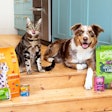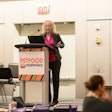
Lynn Dornblaser, director of Innovation & Insight at Mintel, a global market intelligence agency, said there’s more innovation in pet food than human food these days. The pet food market continues to introduce new products, with dog and cat food making up about half of new product introductions.
“About a third of pet food product introductions in the last five years were from new companies or brands, which is much higher than what we see in human food,” noted Dornblaser. “And the greatest percentage of pet food launches appeared in Europe.”
During her session, “Nourishing companions: emerging trends in the global pet food market” that opened the American Feed Industry Association’s Pet Food Conference held in Atlanta on January 30 during IPPE 2024, Dornblaser said there are three key global trends for pet food to explore:
- Product and formula personalization
- Natural and easy-to-understand ingredients
- Sustainability
1. Product and formula personalization
Obesity in pets is a major concern for consumers, and a customized, personalized diet could provide pet owners with assistance, explained Dornblaser.
“A key concern among pet owners – and one that could benefit from a personalized approach is obesity,” she said. “In France, for example, 33% of pet food buyers think their pet would benefit from losing some weight. In the UK, 62% of pet food buyers agree their pet would benefit from losing some weight and would be interested in personalized meal plans.”
Personalization can take many forms, and “health” means many different things to each pet owner. There are products on the market that offer reduced calories, are formulated to support renal function and intestinal balance for senior dogs, and feature prebiotics to support whole body health.
“Pet food consumers now look for products to help in ‘health span’ -- not life span,” said Dornblaser. “They appreciate products that promise to optimize health.”
She noted claims related to wellness have grown on dog and cat food packaging. While changing a pet’s food can be challenging due to the potential for digestive issues because during the transition, consumers seem ready to pivot their pets’ diets to optimize their health.
“In the U.S., a sizeable number of cat and dog owners have changed their pet’s food in the past year in a bid to improve their health and wellness,” said Dornblaser.
What’s the future of product and personalization? Diets tailored to DNA.
While there are dog foods for specific breeds, and DNA testing to understand the breed makeup of pets, there’s a gap for DNA-tailored pet food, said Dornblaser.
“As consumers continue to look for ways to personalize and optimize their own health, we can expect some consumers to consider the same for their pets,” she said. “In France, 31% of pet owners would be willing pay to have their pet’s DNA teste to find out the healthiest diet for the pet. Brands, however, will need to ensure the price is not prohibitive.”
Completely customized healthy formulas can appeal to those consumers willing and able to pay a premium for pet food, said Dornblaser. “Beyond that, offer products that address weight management.”
2. Natural and easy-to-understand ingredients
Like human food, a trend toward natural product values continues to be strong in dog and cat food, with a focus on no artificial ingredients and a small-but-growing chilled and frozen offerings.
“In the U.S., 23% of pet owners look for products with limited ingredient lists,” said Dornblaser.
For example, Mars Petcare expanded its Nutro range with Nutro So Simple, a dog food that is formulated with just a handful of key ingredients, which are illustrated and labelled prominently on the front of the pack.
“No ‘bad stuff’ tends to focus on additives,” said Dornblaser. “Globally, no additives and no artificial colors, flavors or preservatives lead when it comes to claims around overall ‘naturalness.’”
One way to deliver on “naturalness” is frozen or chilled pet food. These offerings are more likely to feature natural claims than shelf-stable launches.
“In order to provide natural products for their furry family members, some pet owners are turning to ‘fresh’ pet food launches, whether frozen, chilled or homemade,” said Dornblaser. “Global frozen and chilled launches are more likely to feature natural claims than shelf-stable launches.”
She did note that only about 1% of product launches in any given year globally are frozen or refrigerated.
What lies ahead for the natural ingredient trend? Frozen/chilled pet food goes more mainstream.
Although the new product introduction numbers are small, retailers are beginning to offer their own frozen/chilled pet food, said Dornblaser. Woolworths, South Africa, offers frozen pet food in the pet aisle freezers. Asda, UK, launched a private label line in 2022, a first for the country. In the U.S., some retailers selling JustFoodForDogs have kitchens where consumers can watch the food prep. And in 2022, Mars acquired Nom Nom Nom, a brand that creates tailored chilled meats.
“In pet food, it’s not about a small number of ingredients, except when it sometimes is,” she said. “Rather, it’s about purity and provenance of the main ingredients.”
3. Sustainability
In the pet food industry, all types of sustainability claims are growing, especially those related to packaging. There are also several benefits linked to ingredient sustainability which provide myriad ways to attract consumers.
As products bearing environmental or ethical claims continue to grow, there are some key areas for the pet food industry investigate, said Dornblaser, including:
- Continued focus on sustainable packaging
- Sustainability of ingredients, including regenerative agriculture
- Upcycled ingredients
- Water use
Consumers want to know about their pet food’s environmental impact, says Dornblaser.
“In the U.S., 61% of pet food buyers want brands to limit their environmental impact,” she said. “In Colombia and Mexica, 62% of consumers say environmentally friendly packaging is important to them when choosing any food, human or pet. In Italy, 79% of pet owners would like to know more about the eco footprint of the pet foods they buy. And in Germany, 54% of pet owners say ethical alternatives to regular pet products are always preferable.
“Consumers want to know what’s in there … it’s that simple,” she said.
Some pet food brands are talking about regenerative agriculture, in line with the movement in human food. “Numbers are small,” said Dornblaser. “But there is interest there.” In the U.S., 74% of consumers say companies should be more transparent about their farming practices.
Interest in upcycled ingredients is also emerging among pet owners. In Poland, 58% of pet food buyers are interested in pet food made with ingredients that would otherwise go to waste; 68% of French consumers think pet food made from leftover ingredients has a positive impact on the environment.
What might be coming down the road in the sustainability trend? A focus on less water use.
“On its packaging, Purina Dog Chow Extra Life Meat and Chicken Double Protein Food from Argentina specifies the manufacturer reduces water consumption by 15%,” explained Dornblaser. “Dasmark Levi Domestic Complete Food from Finland explains on its packaging that ‘potato farming is ecological and requires much less water than, for example, rice farming.’”
Consumers aren’t willing to pay more for basics of sustainability, said Dornblaser. They expect companies to do the heavy lifting and will reward with buying the product – at the same price.
“There are many ways in with sustainability, but addressing packaging is the most common,” she said. “Communicate all that you are doing to be good for the good of pets AND the planet.”
New product trends have been the focus of Lynn Dornblaser’s career for almost 35 years, giving her a unique perspective on the marketplace and new product development. An experienced public speaker, Lynn has been quoted by major U.S. news organizations, including The Wall Street Journal, USA Today, The New York Times and CNN.



















